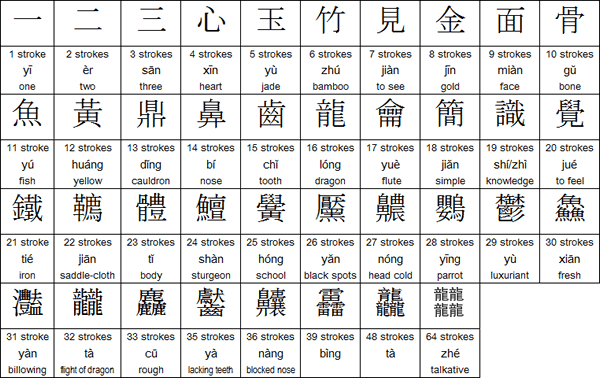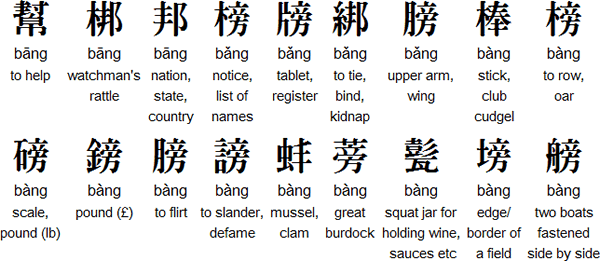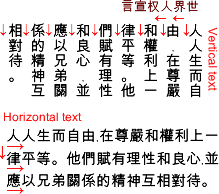Until the early 20th century Classical Chinese (文言 wényán), was the main form of writing in China. There many regional variations in the forms of characters, and they also changed over time, but they were standardised during the Qin Dynasty (秦朝 - 221–206 BC). Classical Chinese was also used in Korea, Japan and Vietnam before they adapted Chinese characters to write their own languages and developed their own scripts.
In Classical Chinese most words were monosyllabic and written with a single character. However, during the 1920s a new form of written Chinese modelled on spoken Mandarin was developed with many words with two of more syllables. Most Chinese publications since then have been written in this form, which is known as 白话 [白話] (báihuà), though some Classical Chinese constructions, especially proverbs, are still used.
Every character has to fit into the same amount of space - an imaginary square - no matter how complex it is. This system was established a Prime Minister Li Si (李斯 - c. 280-208BC) during the Qin Dynasty, who is also credited with creating the Small Seal Script (小篆) There are no spaces between characters and the characters which make up multi-syllable words are not grouped together, so when reading Chinese you not only have to work out what the characters mean and how to pronounce them, but also which characters belong together.
The Chinese writing system is an open-ended one, meaning that there is no upper limit to the number of characters. The largest Chinese dictionaries include about 56,000 characters, but most of them are archaic, obscure or rare variant forms. Some scholars suggest up there are up to 90,000 characters, many of which are not listed in dictionaries and were created only for one ruler, person or purpose.
Knowledge of about 3,000 characters enables you to read about 99% of the characters used in Chinese newspapers and magazines. To read Chinese literature, technical writings or Classical Chinese though, you need to be familiar with at least 6,000 characters.
Knowledge of characters alone is not sufficient in order to read Chinese however - you also need to know what they mean in context and when combined together with other characters. For example, the character 快 (kuài) on its own can mean fast, quick, sharp, straightforward, happy or soon. In combination with other characters it can mean others things:
Source: LINE Dict Chinese-English
Chinese characters are written with the following twelve basic strokes:

A character may consist of between 1 and 64 stokes. The strokes are always written in the same direction and there is a set order to write the strokes of each character. In dictionaries, characters are ordered partly by the number of stokes they contain.

The 39-stroke character (3 x thunder) means "the sound of thunder" and is always written doubled (靐靐). The 48-stroke character (3 dragons) means "the appearance of a dragon walking".
Hear a recording of these characters
There are approximately 1,700 possible syllables in Mandarin, if you include the tones - only 400 or so if you ignore the tones. This compares with some 8,000 in English. As a result, there are many homophones - syllables which sound the same but mean different things. These are distinguished in written Chinese by using different characters for each one.
Not all the following characters are pronounced with the same tone, so to Chinese ears they sound different, but to Western ears they probably all sound the same. These syllables can be distinguished in speech from the context and because most of them usually appear in combination with other syllables.

Hear a recording of these characters by 夏绘 (Xinghua)
If you look closely, you might notice that some of the characters above have parts in common. One element that appears in many of them is 旁 (páng), which means beside, one side, other, side or self, but is used here as a phonetic component to indicate that these characters sound something like páng.
Some of the above characters are rarely used, and many usually appear in combination with other characters, and this helps to distinguish them. For example, 'to help' is 幫助 (bāngzhù), and stick is 棒子 (bàngzi).
It is even possible to write a text in Chinese using only one sound, pronounced with different tones, of course. This is exactly what Chinese linguist, Zhao Yuanren, did when he wrote the "Story of Shi Eating the Lions" using nothing but the sound 'shi'. The story makes sense in written form, but is impossible to understand when read aloud, unless you have memorised it.
You can see and hear the story on:
http://www.yellowbridge.com/onlinelit/stonelion.html
Many Chinese verbs and adjectives consist of one character (syllable) but nouns often consist of two, three or more characters (syllables):
Recordings by 夏绘, and Samuel Chong of Abacus Chinese Translation Services

Traditionally Chinese was written from right to left in vertical columns. The first publication in Chinese using horizontal (left to right) text was Robert Morrison's Dictionary of the Chinese language, published in 1815-1823 in Macau. The increasing use of words in Western languages, especially English, in Chinese texts from the early 20th century made horizontal texts more popular.
Since 1949 horizontal writing has become the standard in the PRC, and all PRC newspapers changed from vertical to horizontal text in 1956, though some headlines are written vertically, as are inscriptions of signs on most state organisations.
The horizontal writing of Chinese is normal in Singapore, and it has been gradually adopted in Hong Kong, Macao and in overseas Chinese communities since the 1990s.
Vertical text remains popular in Taiwan however, though horizontal text is used as well. In Taiwan newspapers and magazines with vertical text, some of the headlines and titles are written horizontally right to left across the top of the main text.
Chinese characters are used to write Modern Standard Chinese, which is based largely on spoken Mandarin. Other varities of Chinese, especially Cantonese, are sometimes written with Chinese characters, or with a combination of characters and words in the Latin alphabet. Some of the characters used are archaic or invented specifically for these languages.
Chinese characters have been used to write Japanese and Korean and Vietnamese. They are still used in written Japanese, in combination with hiragana and katakana, and to a much lesser in written Korean, while Vietnamese is now written with the Latin alphabet.
[ contents ]

Rénrén shēng ér zìyóu, zài zūnyán hé quánlì shàng yīlǜ píngděng. Tāmen fùyǒu lǐxìng hé liángxīn, bìng yīng yǐ xiōngdì guānxì de jīngshén hùxiāng duìdài.
Books about Chinese characters and calligraphy
Mandarin, Shanghainese, Hokkien, Taiwanese and
Cantonese
language learning materials
Written Chinese: Oracle Bone Script, Simplified characters, Bopomofo, Types of characters, Structure of written Chinese, Evolution of characters, How the Chinese script works, Xiao'erjing, General Chinese
Spoken Chinese: Mandarin, Dungan, Wu, Shanghainese, Wenzhounese, Yue, Cantonese, Weitou, Min, Jian'ou, Taiwanese, Teochew, Fuzhounese, Puxian, Hakka, Xiang, Gan, How many people speak Chinese?
Other Chinese pages: Chinese numbers (數碼) | Chinese classifiers (量詞) | Electronic dictionaries | Chinese links | Books: Chinese characters and calligraphy | Cantonese | Mandarin, Shanghainese, Hokkien and Taiwanese
Akkadian Cuneiform, Ancient Egyptian (Demotic), Ancient Egyptian (Hieratic), Ancient Egyptian (Hieroglyphs), Chinese, Chữ-nôm, Cuneiform, Japanese, Jurchen, Khitan, Linear B, Luwian, Mayan, Naxi, Sawndip (Old Zhuang), Sui, Sumerian Cuneiform, Tangut (Hsihsia)
Page last modified: 15.03.23
[top]
You can support this site by Buying Me A Coffee, and if you like what you see on this page, you can use the buttons below to share it with people you know.

If you like this site and find it useful, you can support it by making a donation via PayPal or Patreon, or by contributing in other ways. Omniglot is how I make my living.
Note: all links on this site to Amazon.com, Amazon.co.uk
and Amazon.fr
are affiliate links. This means I earn a commission if you click on any of them and buy something. So by clicking on these links you can help to support this site.
[top]